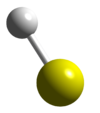
Sulfanyl

Hydrogen disulfideSulfanyl (HS•), also known as the mercapto radical, hydrosulfide radical, or hydridosulfur, is a simple radical molecule consisting of one hydrogen and one sulfur atom. The radical appears in metabolism in organisms as H2S is detoxified. Sulfanyl is one of the top three sulfur-containing gasses in gas giants such as Jupiter and is very likely to be found in brown dwarfs and cool stars. It was originally discovered by Margaret N. Lewis and John U. White at the University of California in 1939. They observed molecular absorption bands around 325 nm belonging to the system designated by 2Σ+ ← 2Πi. They generated the radical by means of a radio frequency discharge in hydrogen sulfide. HS• is formed during the degradation of hydrogen sulfide in the atmosphere of the Earth. This may be a deliberate action to destroy odours or a natural phenomenon. Sulfanyl (HS•), also known as the mercapto radical, hydrosulfide radical, or hydridosulfur, is a simple radical molecule consisting of one hydrogen and one sulfur atom. The radical appears in metabolism in organisms as H2S is detoxified. Sulfanyl is one of the top three sulfur-containing gasses in gas giants such as Jupiter and is very likely to be found in brown dwarfs and cool stars. It was originally discovered by Margaret N. Lewis and John U. White at the University of California in 1939. They observed molecular absorption bands around 325 nm belonging to the system designated by 2Σ+ ← 2Πi. They generated the radical by means of a radio frequency discharge in hydrogen sulfide. HS• is formed during the degradation of hydrogen sulfide in the atmosphere of the Earth. This may be a deliberate action to destroy odours or a natural phenomenon. The organic analogue of sulfanyl is thiyl radical with the formula RS., where R = alkyl or aryl. Absorption lines of sulfanyl in space were first detected in the infrared by Yamamura (2000) in a star R And. In the sun •SH was detected at several ultraviolet wavelengths: 326.0459, 327.5468, 328.9749, 330.0892 and 330.1112 nm. Sulfanyl has been detected in interstellar gas, and it is possibly present in comets. Various theoretical studies have examined HS• in atmospheres. In Earth's atmosphereHS• reacts with NO2 to make two products HSNO2 and HSONO. HSONO decomposes to HSO and NO.HS• also reacts with O2 and N2O. HS• can also react with Cl2 producing HSCl and a Cl• atom. HS• destroys ozone producing HSO• and oxygen. HS• is formed in the Earth's atmosphere by the reaction of HO•, the hydroxyl radical, on carbon disulfide, carbon oxysulfide and hydrogen sulfide with side products of carbon dioxide and water. Photodissociation of hydrogen sulfide also produces the radical in air. In a planetary atmosphere that contains H2S, HS• will be formed if the temperature and pressure are high enough.The ratio of H2S and HS• is given by: For a hydrogen dominated atmosphere in a gas giant or star: H2S has the same level as HS• at At higher temperatures HS• breaks up into sulfur vapour and H2. The line of equal S and HS concentration follows the line The lines of equal concentration cross at 1509 K and 1.51 Pa, with HS• being left out of the mix at lower temperatures and pressures. •SH is expected to be the second or third most common sulfur containing gas in gas giants or brown dwarfs.
